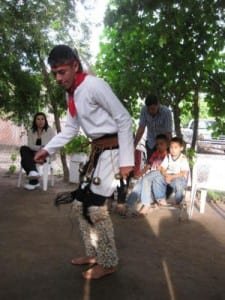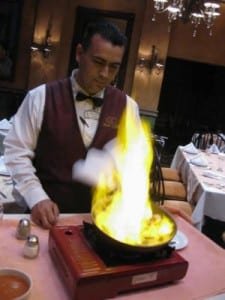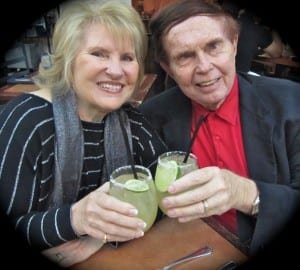Train journeys are high on our priority list. Visiting the Copper Canyon in Mexico was a top spot on our “someday” destination list. When we had an opportunity with the International Food Wine and Travel Writers Association (IFWTWA), we experienced this phenomenon first hand.
Flying from Phoenix was relatively easy, by connecting in Hermosillo, Mexico and transferring to Los Mochis. Any concern about its small airport was unfounded, as it was modern, clean and efficient. Our Aero Mexico jet came through for both segments without any difficulty. The airline’s staff was pleasant to work with and efficient.
In Los Mochis, our trip started at the lowest altitude. We had no idea it was such an industrialized city. We headed for the Hotel Santa Anita, part of the Balderrama group of hotels. All of our rooms were comfortable and provided a good nights sleep.
After breakfast, Mr. Balderrama gave us a brief history lesson about Los Mochis. It was founded in 1903 by an American, Benjamin Johnson, in order to deal with sugar cane harvests. We discovered that Los Mochis was a “breadbasket” for the area. The city was located in the state of Sinaloa, which was heavily agricultural, growing large quantities of corn, tomatoes, beets and sugar.
When the Balderramas realized they were hosting so many journalists who also wrote about food, they sent their corporate chef, Victor Samaniego, with us for a few nights.
Before we left Los Mochis, we went on board the Balderrama charter boat in Topolobampo Bay. This combination port and marine sanctuary was filled with clams, crabs, oysters, scallops, shrimp and much more. Dolphins accompanied us and surrounded our boat, playing with delight.
As we slowed near a fishing boat, the fishermen, in exchange for coca-
On the way to El Fuerte, we went to a Mayo Indian dance exhibition. Their displays showed how original religious rites were often reconciled with Catholic ceremonies by Jesuits and other monks, easing their conversion Christianity. We stopped at a roadside stand and sampled some homemade cookies.
Completion of the Copper Canyon line in 1961 took over 70 years. This time frame was due primarily to the daunting terrain of the Sierra Madre Mountains and the Copper Canyon. Originally, the objective of the line was to carry produce and other goods from Texas and the USA’s Midwest into Mexico, thus avoiding a completely western route to San Francisco. At this point, though, a Pacific port for Mexico had not yet been completed.
Therefore, temporarily, the new railroad carried only passengers. It was the first east/west line that allowed both tourists and locals to travel in these directions when there were no readily accessible roads. Today, the Copper Canyon Railway is the only line that still carries passengers along with freight.
Eventually, the port of Topolobampo became a suitable port for shipping. This allowed the primary switch to produce, so that the Railway’s dual function has continued since.
Our plan was not to stay on the train for the entire 16 hours. As many do, we stopped along the way to stay overnight, explore, and discover a little about the people. The canyons filled us with awe as they opened in front of our eyes. By the time we left the train in Bahuichivo, continuing eight miles by bus to Cerocahui, we had crossed many miles of the breath taking canyon. When we arrived at the rustic Mision Hotel, founded by Roberto Balderrama Gomez in 1961, our elevation was now 4100 feet. Our rooms were like miniature haciendas. Thank goodness each had a wood stove and a good stack of wood, as we needed them at night.
Late afternoon, part of our group chose to learn more about area wine, some hiked to a 70 foot waterfall. Still others, including Maralyn, Frederica Dunn, Kurt and Michelle Winner, departed for a 3-
During the rides first 45 minutes, the group did not realize they would have to ride down hundreds of feet of rocks and stones, cross a river, and then ascend to the waterfall. They thought the ride back would be a short cut, but the return route was exactly the same. Michelle, an accomplished rider said, “This was the most challenging ride of my life.” Frederica had ridden quite a bit, but nothing like this. Kurt and Maralyn, on second and third trail rides ever, said their others had been flat compared to this. Adrenalin was pumping, while each incline and decent were beautiful and scary at the same time. Juan, our guide and his dog Pepe, were exceptional and the horses, Pepino, Lucero, Conejo and Lirio the best ever—thank goodness. As the sun set, we returned to the hotel just past dusk. Our group entered, excited about completing the ride, but telling tales about their levels of fear. Norm was patiently waiting with others, but with an obvious expression of relief.
Early the next morning, we again boarded the train for our ride to Divisadero. The terrain grew more awesome, as we looked outward at deepening chasms. Finally reaching the luxurious Balderrama Hotel Mirador, we saw the climax of our trip. This hotel was situated right at the tip of the Copper Canyon itself, at an elevation of about 8,000 plus feet. Our rooms and verandas, as well as a spacious dining room with porch, were so close to the edge as to provide a breathtaking view of the Canyon’s incredible expanse.
Divisadero was home to numerous lovely hotels. It was raining, but we wanted to see views from other hotels. Hotel Mansion Tarahumara was like a white castle with red tile roofs, and its stone walls and turrets seemed like a journey into another time. It featured a great room (that really was a great room) for dining. Right next to the dining area was an equally charming, but very intimate, bar. Its hospitality and tequila warmed us from the rain.
Hotel Divisadero Barrancas offered service, spectacular views, plus more tequila. Due to time constraints, we did not visit some other fine hotels. We eagerly escaped back to the Hotel Mirador, took a shower and enjoyed Margaritas, while looking out over the canyon.
The next morning we watched the sunrise from out hotel verandas, as it gradually rose above the canyon. Later, at breakfast in the dining room, we could enjoy our food and still partake of all the canyon’s wonders.
We took a walk along the rim and shopped among local Tarahumaras, who were selling their handicrafts. In the afternoon, we boarded the train for Creel. But before we left this area, we wanted to record some details on the canyon itself.
Let’s face it—the Copper Canyon (Barranca del Cobre) is not listed as one of the seven (or whatever number) wonders of the world—but it should be. It’s at least four times the size of the world-
At the very depth of Copper Canyon, vegetation and plants are of a tropical variety. Bananas, limes, mangos and the like grow there. At the upper extremities of the great formation, where freezing temperatures and even snowfalls are normal and expected, delicious apples are grown.
Over the years, considerable gold and silver have been mined throughout the Canyon, but no copper at all.
For hardy souls (make that “soles” also), it was possible to use several trails to hike the entire distance down to the Copper Canyon base. At one lookout point, an extension had a glass floor, which provided a stunning view all the way down. One brief crossing allowed passing from one end of the point across the Canyon to another end. This was nothing like venturing from the South Rim to the North Rim of the Grand Canyon, but was still quite exciting. Next May, 2010, the goal is to complete a “venicula”, a form of tram which will automatically transport sightseers up and down the Copper Canyon’s depths.
Communities along this trip varied. Once we were on the train, several of our stops qualified as “colonial towns.” All such historical sites featured a Roman Catholic mission, a park across from the mission, and a government building close by. Colonial towns included El Fuerte, Cerocahui, Creel, and Chihuahua itself, the lattermost with over one million population.
After Los Mochis, each town featured at least one quaint colonial hotel. In Creel, the next town along our route, the Villa Mexicana provided charming separate cabins. An alternative location in the same town was the Best Western, with very impressive decorations and dining areas.
Our final destination on the trip was the Hotel Sicomoro in Chihuahua. It was a terrific experience, featuring traditional tasty Mexican food. In all these towns, in shops and along many sidewalk and roadway locations, Indians and other Mexicans sold a variety of crafts, shawls and other creations.
We visited reservations and dwelling sites of several Indian tribes. One extremely interesting Indian group was the Tarahumaras. Mostly semi-
We were surprised to visit a Mennonite community in Chihuahua. Now numbering about 55,000, they immigrated to Mexico from Canada in 1922. Earlier, they had traveled to the Western Hemisphere from Germany, Poland and Russia to escape religious and political persecution.
Mennonites are “Anabaptists”, meaning they disavow infant baptism. In western Canada, their community of about 7000 contended with the government over their desire to educate children solely in German. This led to a wholesale resettlement in Mexico.
Chihuahua is a city and state in Mexico and well worth a visit. Bordering the United States and bustling with variety, it featured many more sites than we were able to explore in a day.
All in all, we encountered fascinating varieties of sites and people in Mexico, while still enjoying completely satisfactory creature comforts. To restate, VIVA COPPER CANYON, the CHEPE RAILROAD, and FRIENDLY COMMUNITIES VISITED!
Our IFWTWA trip was organized by Juan Rodriguez, Director, Mexico Adventures Inc., at 1-
This article was originally published on Vacation Station.com and they prepared the video on YouTube from Maralyn’s photos.
If you would like to submit a guest post on food, wine or travel to Where and What in the World, we would be happy to feature your travel experience , drink, special wine tasting, or family or simply delicious recipe. If you go to submission tab, you will see how to submit, as well as have the opportunity of telling us if you would like to would like to be a regular contributor. When uploading a file for submission, you are also able to upload jpgs. Please feel free to put a last paragraph about you and a link to your profile. No html please. You can also include a head shot.
Maralyn D. Hill, The Epicurean Explorer & Norman E. Hill, Journalist
MDH-Board Member & Past President, NEH – Member International Food Wine & Travel Writers Association
Where and What in the World, Books By Hills & Success with Writing




















